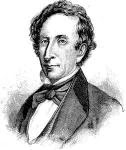John Tyler (29 March 1790 – 18 January 1862) was the tenth President of the United States (1841–1845), after being the tenth Vice President of the United States (1841). A native of Virginia, Tyler served as a state legislator, governor, U.S.
representative, and U.S. senator before being elected Vice President in 1840. He was the first to succeed to the office of President on the death of the incumbent. Tyler's opposition to nationalism and emphatic support of states' rights endeared him to his fellow Virginians but alienated him from most of the political allies that brought him to power in Washington. His presidency was crippled by opposition from both parties. Near the end of his life, he supported the secession movement in the southern states, and was elected to the Congress of theConfederate States of America.
Tyler was born to an aristocratic Virginia family of English descent and he came to national prominence at a time of political upheaval. In the 1820s, the nation's only political party, the Democratic-Republicans, split into factions, most of which did not share Tyler's strict constructionist ideals. Though initially a Democrat, his opposition to Andrew Jackson andMartin Van Buren led him to alliance with the Whig Party; he was elected Vice President In 1840 on the Whig ticket. Upon the death of President William Henry Harrison on 4 April 1841, only a month after his inauguration, a short Constitutional crisis arose over thesuccession process. Tyler immediately moved into the White House, took the oath of office, and assumed full presidential powers, a precedent that would govern future successions and eventually be codified in the Twenty-fifth Amendment.
As President, Tyler opposed the Whig platform and vetoed several of their proposals. As a result, most of his cabinet resigned, and the Whigs, dubbing him His Accidency, expelled him from the party. While he faced a stalemate on domestic policy, he still had several foreign policy achievements, including the Webster–Ashburton Treaty with Britain and theTreaty of Wanghia with Qing China. Tyler dedicated his last two years in office to theannexation of Texas. He sought re-election to a full term, but he had alienated Whigs and the Democrats wouldn't have him back. His efforts to form a new party came to nothing. However, in the last days of his term, Congress passed the resolution authorizing annexation, which was carried out by Tyler's successor as President, James K. Polk.
Tyler essentially retired from electoral politics until the outbreak of the Civil War in 1861. He sided with the Confederate government, and won election to the Confederate House of Representatives shortly before his death. Although some have praised Tyler's political resolve, his presidency is generally held in low esteem by historians; today he is considered an obscure president, with little presence in the American cultural memory
representative, and U.S. senator before being elected Vice President in 1840. He was the first to succeed to the office of President on the death of the incumbent. Tyler's opposition to nationalism and emphatic support of states' rights endeared him to his fellow Virginians but alienated him from most of the political allies that brought him to power in Washington. His presidency was crippled by opposition from both parties. Near the end of his life, he supported the secession movement in the southern states, and was elected to the Congress of theConfederate States of America.
Tyler was born to an aristocratic Virginia family of English descent and he came to national prominence at a time of political upheaval. In the 1820s, the nation's only political party, the Democratic-Republicans, split into factions, most of which did not share Tyler's strict constructionist ideals. Though initially a Democrat, his opposition to Andrew Jackson andMartin Van Buren led him to alliance with the Whig Party; he was elected Vice President In 1840 on the Whig ticket. Upon the death of President William Henry Harrison on 4 April 1841, only a month after his inauguration, a short Constitutional crisis arose over thesuccession process. Tyler immediately moved into the White House, took the oath of office, and assumed full presidential powers, a precedent that would govern future successions and eventually be codified in the Twenty-fifth Amendment.
As President, Tyler opposed the Whig platform and vetoed several of their proposals. As a result, most of his cabinet resigned, and the Whigs, dubbing him His Accidency, expelled him from the party. While he faced a stalemate on domestic policy, he still had several foreign policy achievements, including the Webster–Ashburton Treaty with Britain and theTreaty of Wanghia with Qing China. Tyler dedicated his last two years in office to theannexation of Texas. He sought re-election to a full term, but he had alienated Whigs and the Democrats wouldn't have him back. His efforts to form a new party came to nothing. However, in the last days of his term, Congress passed the resolution authorizing annexation, which was carried out by Tyler's successor as President, James K. Polk.
Tyler essentially retired from electoral politics until the outbreak of the Civil War in 1861. He sided with the Confederate government, and won election to the Confederate House of Representatives shortly before his death. Although some have praised Tyler's political resolve, his presidency is generally held in low esteem by historians; today he is considered an obscure president, with little presence in the American cultural memory

